How to Make a Cover Page: Illustrative Formatting Examples
Table of contents
- 1 What Is a Cover Page for an Essay?
- 2 How to Format a Cover Page (General Guidelines)
- 3 How to Make an APA Cover Page? (With an Example)
- 4 How to Make an MLA Cover Page? (With a Template)
- 5 How to Do a Cover Page for an Essay in a Chicago Style?
- 6 How to Make an ASA Cover Page?
- 7 How to Make a Harvard Cover Page?
- 8 Conclusion: Creating a Professional Cover Page
What Is a Cover Page for an Essay?
An essay cover page is the first page of student papers that provides essential details about the work. It is also referred to as a front sheet and serves as the formal introduction to an essay. Depending on the formatting style specifically requested by your instructor or institution, the essay cover page may include elements such as:
- The title of your essay;
- Your name;
- The class title;
- The instructor’s name;
- The submission date.
Why Is a Cover Page Important?
A well-formatted cover page is an essential part of an essay’s presentation. It sets the tone for the rest of your paper and makes a great first impression on your instructor. Properly structured student papers demonstrate attention to detail and academic discipline.
Additionally, a front sheet helps organize your work by clearly displaying the title of your essay and other relevant information in a standardized format.
What Happens If a Cover Page for Essay Is Missing?
If your essay cover is missing or incorrectly formatted, it can lead to several issues:
- Your instructor may deduct points for improper formatting.
- The first page of your essay may look disorganized or unprofessional.
- The title of your essay may be unclear, making it harder for instructors to identify your work.
- If the cover sheet is specifically required, not including it could result in rejection or a lower grade.
How to Format a Cover Page (General Guidelines)
A properly formatted cover page enhances the professionalism of your paper and ensures it meets academic standards. Whether you’re in school or university, following specific guidelines for cover pages is essential.
Essential Elements of a Cover Page
A first sheet should include all the information necessary to identify your work.
- The title of the paper (centered and in the correct capitalization style);
- The first and last name of the author (or multiple authors, if applicable);
- The class name;
- The date of submission;
- The name of the instructor;
- A header (if required by the formatting style).
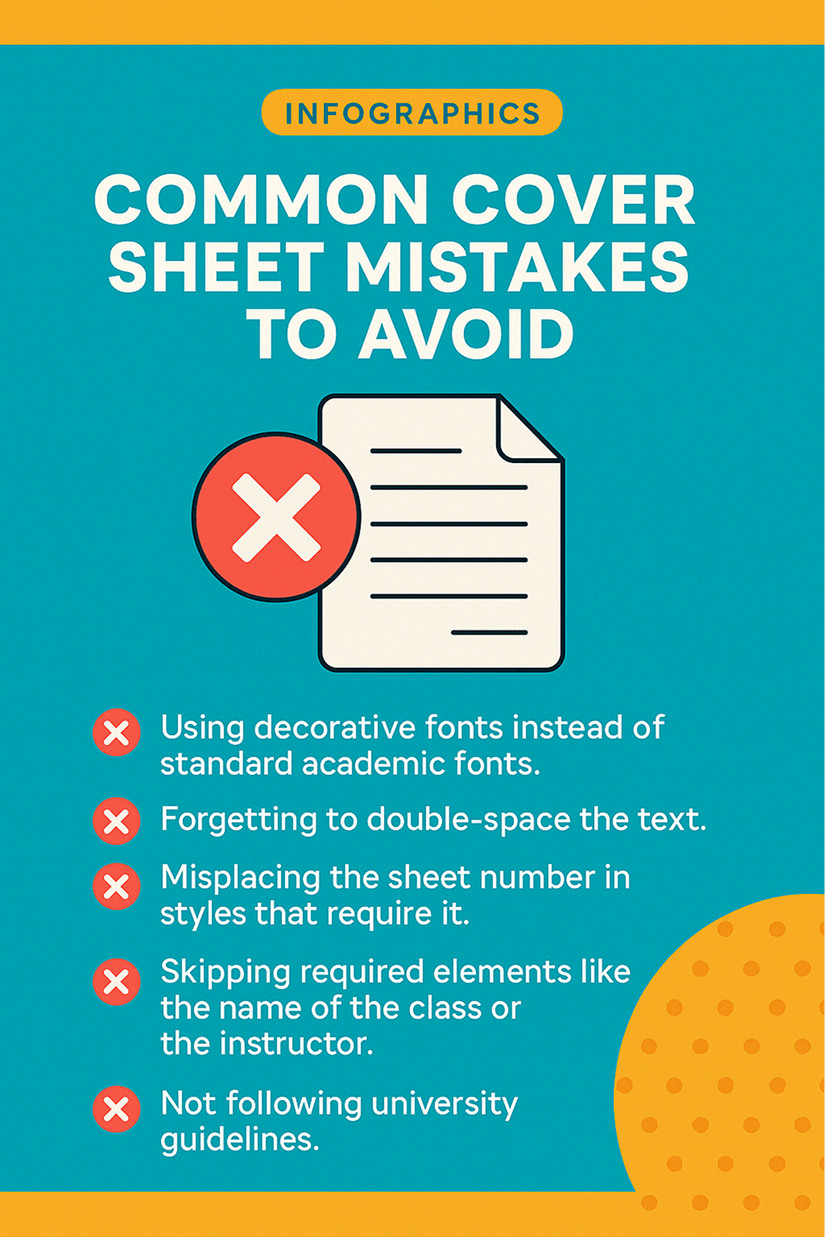
Common Formatting Rules (Margins, Fonts, Spacing)
When writing the first sheet, follow these common formatting rules to ensure consistency:
- Margins: Keep every margin at one inch on all sides.
- Font: Use a readable font such as Times New Roman font or Arial.
- Font Size: The standard size is 12-point font.
- Line Spacing: Most formats require double-line spacing throughout.
- Header: In some styles, a header is placed at the top of the sheet, which may include a shortened author name or a one-half-inch running head.
If you’re unsure about the correct formatting, you can always refer to our detailed guide on how to format an essay correctly.
How to Make an APA Cover Page? (With an Example)
The APA citation format is widely used in school and academic writing, but it comes with certain challenges. Many students, especially those balancing multiple classes, prefer to order cheap essays instead of dealing with complex formatting rules. However, if you’re creating an APA-style first sheet for your first sheet, following the correct structure ensures professionalism and adherence to academic standards.
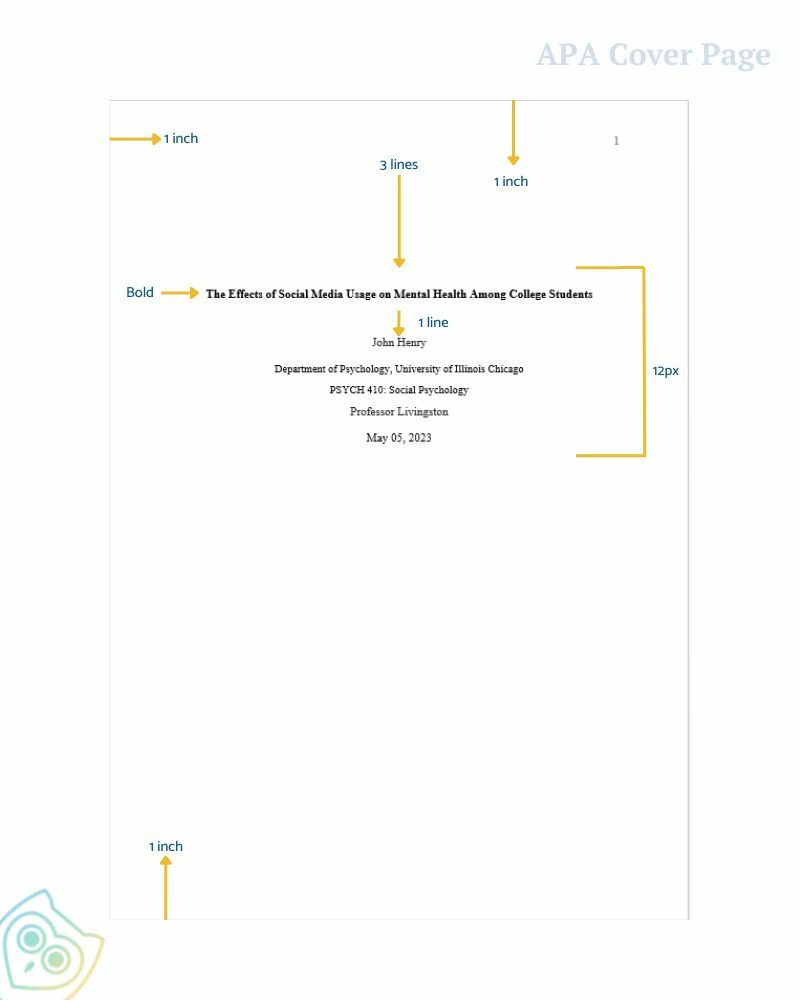
When to Use APA Format?
APA format is commonly used in psychology, social sciences, business, and education papers. If your professor or class name requires APA formatting, you’ll need to apply its cover page rules. Your paper title, author name, and other details should be structured consistently with APA guidelines.
Key Elements of an APA Cover Page
To create an APA title page, ensure the following elements are included in the proper style:
- The paper title is centered at the top of the first page.
- Your name is centered below the title on its own line.
- The institutional affiliation (college or university name) is centered below your name on the next double-spaced line.
- The course name and course number are placed below the institutional affiliation.
- Your professor’s name is written on the same line as the course number.
- The due date is placed on the final line.
- Page number is aligned to the top-right corner.
- Optionally, a running head, aligned to the left margin with “Running head:” is followed by a shortened version of the paper title.
APA Essay Cover Page Template
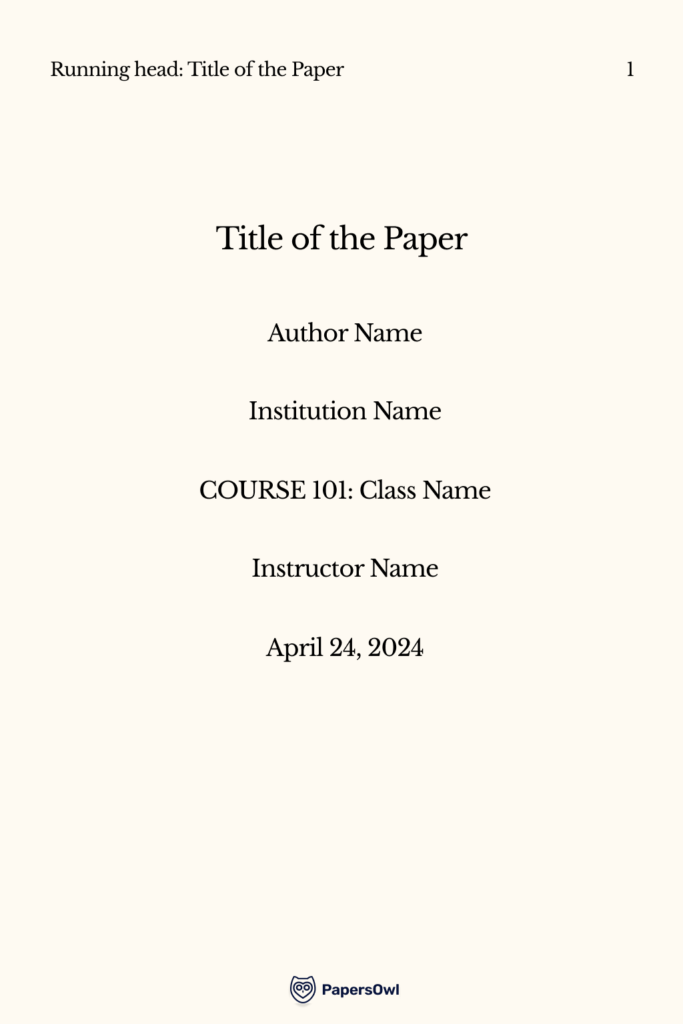
| Element | Structuring |
| Paper Title | Centered at the top of the page, in bold, under 12 words |
| Title Author | Centered below the title on its own line |
| Institution Name | Centered below author’s name on the next line |
| Course Number | Placed below the institution name |
| Class Name | On the same line as the course number |
| Instructor’s Name | On the next double-spaced line |
| Deadline | Placed on the final line, in Month Day, Year format |
| Page Number | The top-right corner of the first page |
| Running Head | Left-aligned, optional |
How to Make an MLA Cover Page? (With a Template)
The MLA format is often used in school and university settings, especially in the humanities, such as literature, language, and cultural studies. It’s commonly used for writing assignments in English classes, essays, or research papers that require consistent formatting and citation. If your instructor has asked you to create an MLA cover page, this style ensures that your paper adheres to the necessary guidelines.
MLA style is especially important when submitting essays in writing or projects that involve multiple sources. It provides a clear structure and ensures consistency across documents. Whether you’re working on a group project or writing your paper, MLA helps ensure your document maintains professionalism and academic integrity.
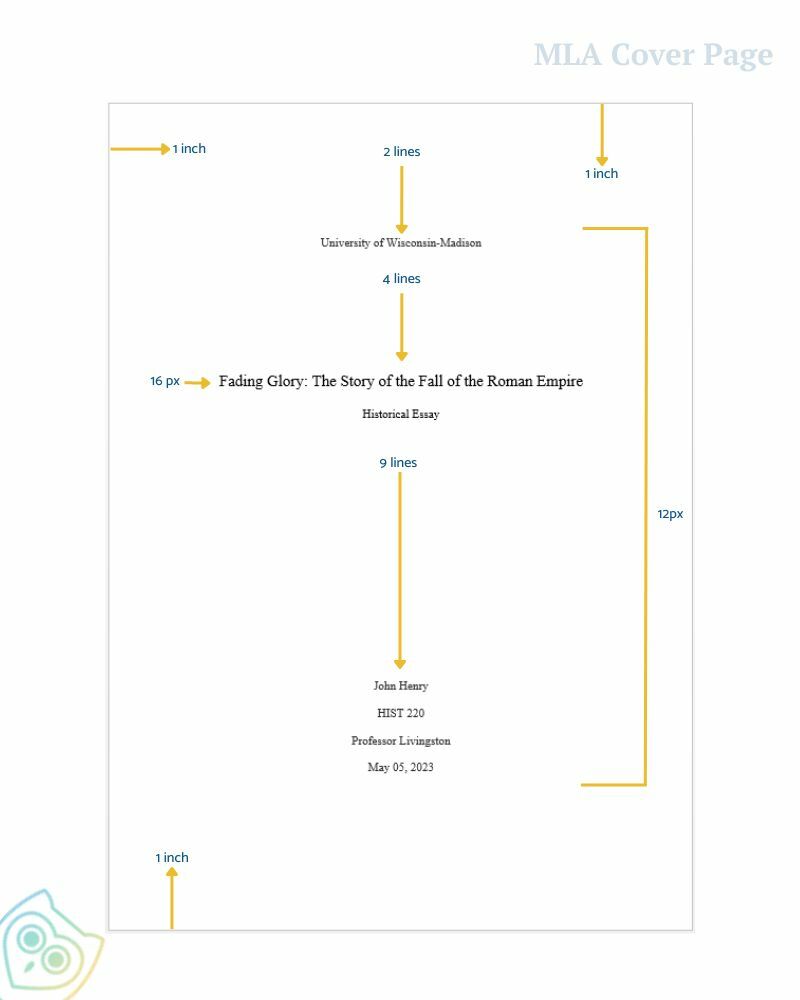
Consequences of Incorrect MLA Formatting
Incorrect MLA formatting can negatively impact the overall presentation of your essay. Some of the potential consequences include:
- Incorrect header placement – The running header should appear in the upper right corner of each sheet. It should include your last name and sheet number half an inch from the top of the page.
- Missing or incorrect page number – Failure to include a title page in MLA or improperly placing it will lead to a lack of professionalism. The number should be positioned in the upper right corner.
- Misalignment of basic information – Ensure the first and last names appear one inch from the top of the sheet and follow the university guidelines.
- Formatting issues with spacing and margins – The text must be double-spaced, with one-inch margins on all sides.
- Missing or incorrect quotation marks or indentation – The first line of each paragraph must be indented half an inch. Failure to do this will make the paper look unprofessional.
- Incorrect title alignment – Ensure essay titles are centered and in headline style.
Following the correct MLA essay format ensures you avoid these issues and present your work clearly.

Step-by-Step MLA Cover Page Structuring
To create an effective MLA cover page, follow these steps:
- Title Placement: Titles should be centered about one-third of the sheet’s length. Use headline style and ensure no bold or italics unless required for specific terms.
- Author’s Name: The first and last name should be placed one inch from the top of the sheet, aligned with the left margin.
- Instructor’s Name: Directly below your name, include the name of the instructor, followed by the course name and course number.
- Date: It should be written in day-month-year format (e.g., 12 May 2025) and placed below the course information.
- Page Number: In the top right corner, include your last name and the page number half an inch from the top.
- Structuring: Use Times New Roman font, size 12, and ensure double-spaced lines throughout the document.
- Multiple Authors: If you have three or more authors, list each name on a separate line.
- Indentation: Ensure that the first line of every paragraph is indented by half an inch.
MLA Title Page Example (With a Template)

| MLA Cover Page Style | Example |
| Title (Centered, Title Case) | The Impact of Modern Literature on Society |
| Student’s First and Last Name | Jane Doe |
| Instructor’s Name | Dr. John Smith |
| Course Name and Number | English 101 |
| Date (Day-Month-Year) | 12 May 2025 |
| Running Header (Top Right Corner) | Doe 1 |
How to Do a Cover Page for an Essay in a Chicago Style?
When formatting your front sheet in Chicago style, it’s essential to follow specific structuring rules. The Chicago style paper style is widely used in humanities and history classes, and its cover page includes key details like the essay title, author name, course tag, instructor’s name, and due date. Understanding how to make a cover page for an essay in this style ensures your work looks polished and professional.
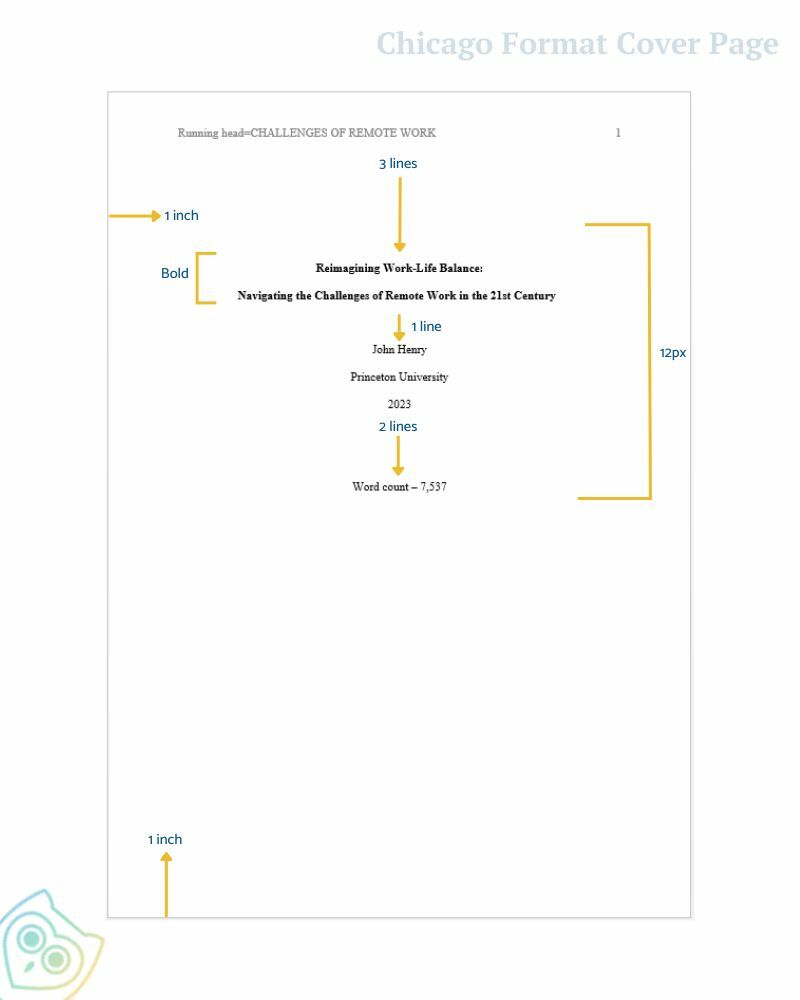
Key Features of Chicago Cover Pages
A properly structured Chicago title sheet should include the following basic information in a structured layout:
- The essay title is centered one-third to halfway down the sheet, using title case (capitalize major words).
- The author’s name is centered below the title on a double-spaced line.
- The class title is centered below the author’s name.
- The instructor’s name is placed on the same information line as the class title.
- The due date is centered below the instructor’s name.
- A shortened title and sheet number may appear in the header of subsequent sheets, though sheet numbers are typically omitted from the front sheet.
Additionally, your writing should maintain consistency by using the same font on the cover page and throughout your university paper.
Similarities Between Chicago and Turabian Styles
The Chicago and Turabian styles share several formatting rules for cover pages:
- Both styles place the front sheet one-third to halfway down the sheet, centered.
- The essay title follows title case formatting.
- The author’s name is listed below the title.
- The university or institutional affiliation is sometimes included below the author’s name.
- Neither style typically includes a sheet number on the front sheet.
For additional details on structuring your Chicago-style cover page correctly, you can also consult an essay writer service for practical formatting tips and guidance.
Example of a Chicago Cover Page

- Title centered one-third to halfway down the sheet;
- Author’s name centered, double-spaced below the title;
- Course title centered, double-spaced below the author’s name;
- Professor Name centered, same information line as course title;
- Date centered on the final double-spaced line.
How to Make an ASA Cover Page?
The ASA title page follows a structure similar to the APA essay style but with a few key differences. ASA style is commonly used in sociology and requires specific details like a running head, total word count, and unique sheet number placement. Understanding these distinctions ensures your writing meets academic standards.
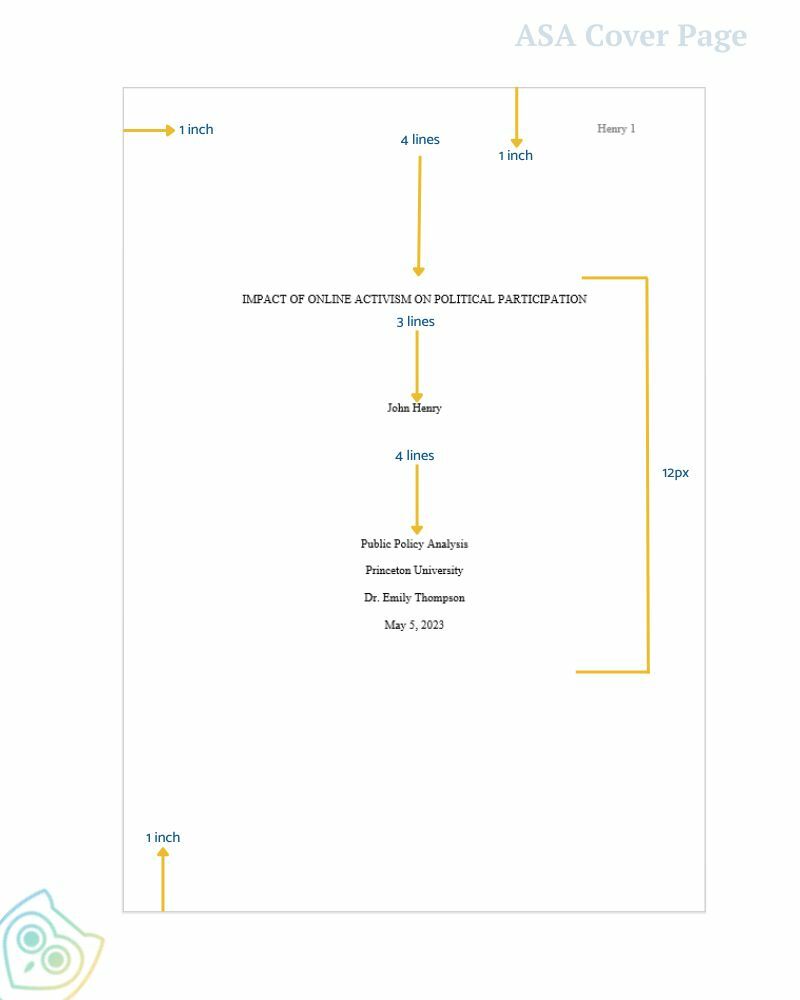
Key Differences Between ASA and APA Cover Pages
While ASA and APA title pages share many formatting elements, here are the primary differences:
- ASA requires a running head that is under 60 characters.
- The front cover must include the word count of the entire paper, including footnotes and references.
- Page numbers start on the front cover and must be placed in the bottom-right corner instead of the top-right.
- If the research was conducted at multiple institutions, all affiliations must be listed vertically below the final author’s name and class.
Required Elements for an ASA Cover Page
A properly structured ASA title page should include the following details:
- A running head is left-aligned at the top of the sheet, under 60 characters.
- The front sheet title is centered and in the title case.
- The final author’s name is centered below the title.
- The class name is centered below the author’s name.
- Institutional affiliations (if applicable) is listed vertically below the class name.
- The total word count, including footnotes and references, is placed on the front cover.
- Page numbers start on the front sheet, aligned to the bottom-right corner.
ASA Cover Page Example
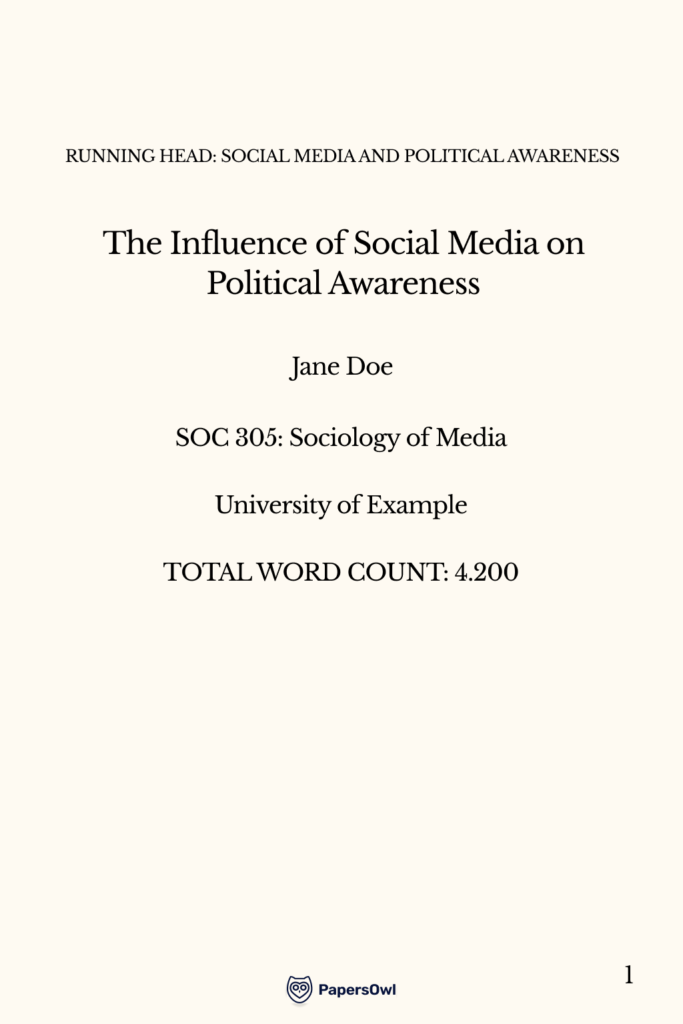
Here’s an example of a properly structured ASA title page:
- Running head (left-aligned at the top, under 60 characters)
- Centered title, in headline style
- Final author’s name, centered
- Centered name of class
- Centered institution name
- Total Word Count (centered on a new line)
- Sheet number at the bottom-right corner
By following these guidelines, your ASA title page will align with academic expectations. If you need further clarification on the style, you can refer to the APA essay format for additional insights.
How to Make a Harvard Cover Page?
The Harvard title page is a key component of academic writing in the social sciences and humanities. This style is commonly used in subjects like literature, history, and economics. A properly structured front cover ensures clarity and professionalism while maintaining consistency with Harvard referencing guidelines.
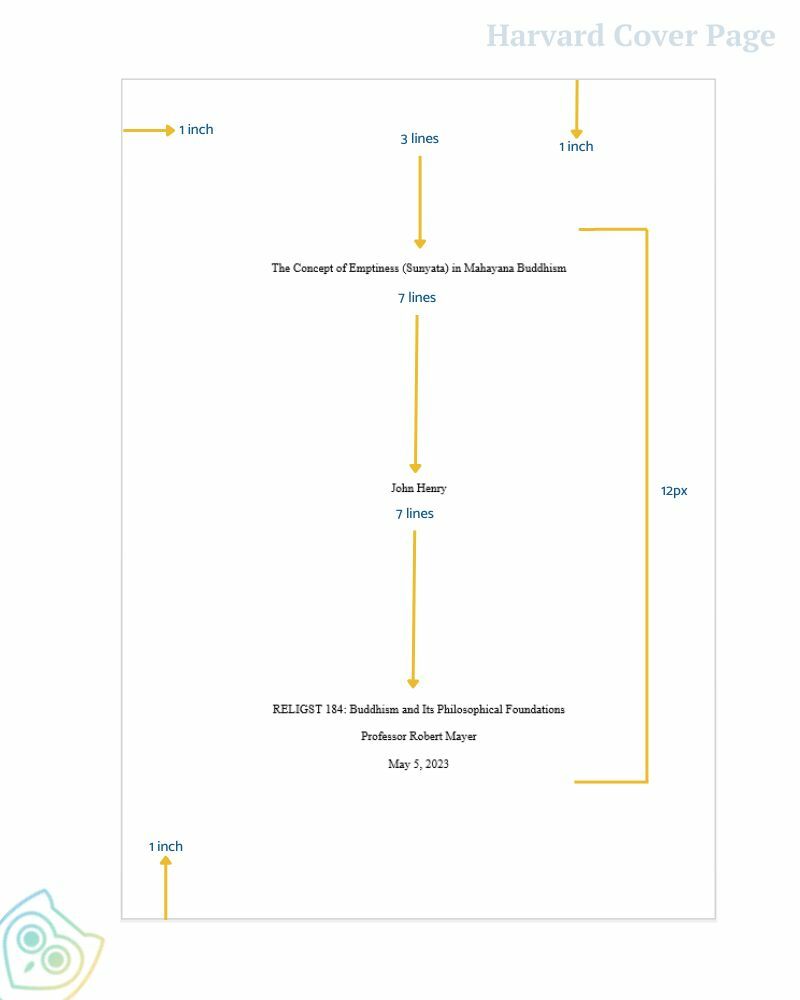
When to Use Harvard Formatting?
Harvard style is typically required in disciplines that emphasize research and critical analysis. If your instructor or institution specifies the Harvard title page style, it’s essential to follow the correct order and structure. Beyond the front cover, this style also requires in-text citations and a reference list that provides full bibliographic details for sources.
Structure and Order of Elements
A standard Harvard title page follows this structured order:
- Title of the research paper – Centered at the top of the page.
- Author’s name – Written as “Last Name, First Initial” and centered below the title.
- Date of submission – Placed below the author’s name.
- Class number and name – Centered below.
- Instructor’s name – Listed at the bottom of the front cover.
Example of a Harvard Cover Page

Here’s how a Harvard title page should be structured:
- Title centered at the top of the page
- Name centered below the title
- Date centered below the author’s name
- Course name centered below the date
- Professor name centered at the bottom of the page
By following these guidelines, your Harvard title page will ensure clarity in your writing.
Conclusion: Creating a Professional Cover Page
A well-structured cover page enhances the professionalism of your paper and ensures it meets academic standards. Whether you’re using MLA style or another style guide, proper structure demonstrates attention to detail and makes your work easier to evaluate. A clear and correctly structured MLA title page or any other required title page helps establish credibility and ensures your paper starts on the right note.
To create a polished and effective title page, keep these tips in mind:
- Follow the MLA title page guidelines or the style required by your instructor.
- Use consistent fonts, spacing, and margins to maintain a professional look.
- Double-check all elements, including the title, author name, and class details.
- Avoid unnecessary styling and stick to standard formatting guidelines.
- Proofread to ensure accuracy before submitting your final document.







